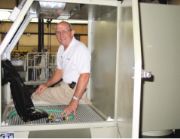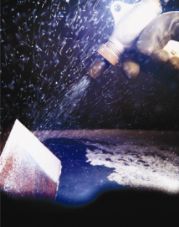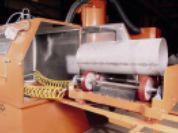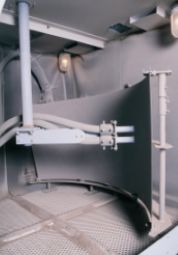E-Archive
Cover Page
in Vol. 3 - November Issue - Year 2002
Sample Processing Proves Value of Automated Blasting

Author Herb Tobben manages the sample processing lab at Clemco Industries Corp.


A roller system mounted on powered work car allows simultaneous internal and external blasting of this tubular weldment.

A pivoting/oscillating arm maintains precise nozzle angle and distance while depainting this curved aircraft skin section.

An eight-nozzle array removes tooling marks, burrs, and casting lines to leave a uniform satin finish on these pistol components prior to plating.
Clemco Industries Corp. manufacturers automated blast cabinets, blast rooms, blast cabinets, portable blast machines, and a complete line of nozzles and other blast components. The company has a worldwide network of licensees, subsidiaries, and distributors.
Clemco Industries Corp. offers a free sample processing service to help customers of its ZERO brand equipment determine if automated blast cleaning or shot peening would improve their operations.
Obviously the benefit of free sample processing service comes from the potential for a sale, but sample processing provides clear advantages as well for the company owner, project manager, or engineer.
First, this company based in Washington does the R & D work in their lab, using experienced technicians operating their own equipment. As a customer, one does not need to buy a blast system, learn to use it, then try to create a process for ones own application. Clemco has designed systems to efficiently handle everything from fragile silicon wafers to massive space shuttle fuel tanks. This experience gives a head start narrowing down the parameters for parts handling and blasting.
Second, the American manufacturer has the resources to do the work without compromise. Creating custom fixtures is easy, because their engineers and technicians have direct access to machine tools, metal fabrication equipment, and a urethane mold shop. They do not sell blast media, but stock just about every type, in every mesh size imaginable exclusively for sample processing.
And third, after processing representative samples of actual parts, their expertise can evaluate, not just the best way to do the job, but what production rate one can realistically expect. The customers also know what the equipment will cost to purchase and to operate.
The sample processing technicians test blast or shot peen representative parts, provided by customers, while modifying the variables to get the best results. These variables include:
-suction or pressure blasting
-number and size of nozzles or guns
-position of nozzles or guns (distance, angle, spacing)
-blast pressure
-dwell (amount of blast time a surface receives)
-nozzle oscillation speed
-part movement
-media composition and size
The goal is to design an automated system to get the desired finish, consistently, and economically. Many customers ask what criteria is used to determine if an application could benefit from automation. Customers are surprised all the time with unique applications, but a few common characteristics usually indicate that a part is a candidate for automation.
The simplest automated blast applications take parts of relatively consistent size, shape, and condition, and apply a predetermined process to produce identical results over a long production run. With the help of quick-change fixtures and programmable controllers, however, one can build machines to handle an assortment of parts over short or long production runs.
So how does one know if sample processing will be a benefit? If one or more of the following issues is of importance, it might be worth evaluating a sample processing:
-Surface preparation has become a bottleneck in the production line. This includes chemical processes, hand sanding, or manual blasting.
-Two or more employees spend more than half of each day cleaning parts. An automated blast system will speed production and can significantly reduce the risk of repetitive-motion injuries.
-A surface preparation involves toxic chemicals. (When one factors in the health and safety issues, environmental compliance requirements, and disposal costs for chemicals, an automated blast system can usually pay for itself in less than a year.)
-A current process produces inconsistent results or causes excessive rework. This is especially true for shot peening, where verifiable and repeatable results are critical to part performance.
-A current process takes too long. Or, drying the parts after chemical processing takes too long.
-In the past year, one has worn out a manual blast cabinet or has spent more than half the cost of a new manual cabinet keeping your old one running.
For many people, blasting conjures images of aggressive abrasives cleaning rust and paint from steel. But, the American manufacturer has sold systems to automatically blast just about every material one can imagine – aluminum, plastics, glass, fiberglass, silicon wafer, cloth, titanium, ceramics, wood, brass and yes, tons of steel.
ZERO automated systems clean thermos bottles, degloss fiberglass boat hulls, relieve stress in glass ingots, deburr dental braces, satin finish automotive trim, prepare aluminum baseball bats for coatings, etch cookware to accept non-stick coatings, refurbish brass water meters, and so much more.
Clemco can help to evaluate a current process, and show how automated blasting can save time and money, while improving the overall quality of a company’s products.
Clemco Industries Corp.
One Cable Car Drive, Washington
Mo 63090
USA
Tel: +1.636.239 0300
Fax: +1.636.239.0788



























